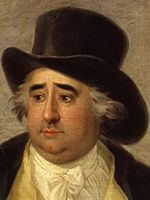Fox–North coalition facts for kids
Quick facts for kids Fox–North coalition |
|
|---|---|
 |
|
| April–December 1783 | |
 
Fox (left) and North (right)
|
|
| Date formed | 2 April 1783 |
| Date dissolved | 18 December 1783 |
| People and organisations | |
| Monarch | George III |
| Prime Minister | Duke of Portland |
| Secretaries of State | |
| Total no. of members | 15 appointments |
| Member parties |
|
| Status in legislature | |
| Opposition party | |
| Opposition leaders | |
| History | |
| Legislature term(s) | |
| Predecessor | Shelburne ministry |
| Successor | First Pitt ministry |
The Fox–North coalition was a government in Great Britain that lasted for a short time in 1783. It was called a "coalition" because it brought together two different political groups. These groups were led by Charles James Fox and Lord North. Even though they led the groups, the official head of the government was William Cavendish-Bentinck, 3rd Duke of Portland, who became Prime Minister on April 2, 1783.
Contents
How the Coalition Government Formed
Fox was a member of the Whig group, and North was from the Tory Party. These were the two main political parties in Britain at the time. Even though they were from different parties, both Fox and North were unhappy with the government led by Lord Shelburne.
They decided to work together in the House of Commons, which is where elected representatives meet to make laws. By combining their votes, they were able to remove Shelburne's government from power. After that, they formed their own government, the Fox-North coalition.
King George III's Dislike of the Coalition
King George III really disliked this new government, especially Charles James Fox. The King tried to find someone else to lead the country, even offering the job to William Pitt the Younger several times. However, no other government could be formed at that moment.
Because the King disliked them so much, he refused to give the government the usual "patronage." This meant he wouldn't help them by giving out important jobs or favors, which governments often used to keep support. So, the Fox-North government had to find other ways to gain and keep support.
Important Events During Their Time in Power
Ending the American Revolutionary War
One very important event that happened during this government's time was the signing of the Treaty of Paris. This treaty was signed on September 3, 1783. It officially brought an end to the American Revolutionary War, which had been going on for many years.
Ideas for Political Change
The government also faced challenges from the opposition. William Pitt the Younger suggested a new law to change how elections worked. He wanted to stop bribery and fix "rotten boroughs." Rotten boroughs were places with very few voters but still had a lot of power in Parliament.
Pitt's idea did not become a law, but it caused problems within the coalition. Some members of the Fox-North government supported political changes, while others were against them. This disagreement created tension among them.
The East India Company Bill
The British East India Company was a powerful trading company that was in financial trouble. Charles James Fox suggested that the government should take control of the company. He thought this would give the government new ways to give out jobs and keep its supporters happy.
This idea was put into a bill called the East India Bill. It passed in the House of Commons. However, King George III was strongly against it. He sent a message to the House of Lords, which is the upper house of Parliament. He told the Lords that he would consider any peer (a member of the House of Lords) who voted for the bill to be his enemy.
Because of the King's strong opposition, the East India Bill was defeated in the House of Lords on December 17, 1783. The King immediately fired the Fox-North coalition government. A new government was then formed by William Pitt the Younger.
After the Coalition Was Dismissed
After being fired, Fox and North tried to force Pitt to resign by defeating him in the House of Commons. But Pitt refused to step down. People across the country showed strong support for Pitt and opposition to the Fox-North coalition. This was seen in petitions, decisions by town councils, and actions by crowds in London.
In March 1784, a general election was held. Pitt's government won a huge number of new seats, especially in areas where people voted directly. This showed that the public supported Pitt over the former coalition.
Images for kids
-
In A Block for the Wigs (1783), James Gillray made a funny drawing of the Fox–North coalition. Fox is on the right, followed by North, and then by Edmund Burke. King George III is the "blockhead" in the middle.
See also
- Cameron–Clegg coalition


